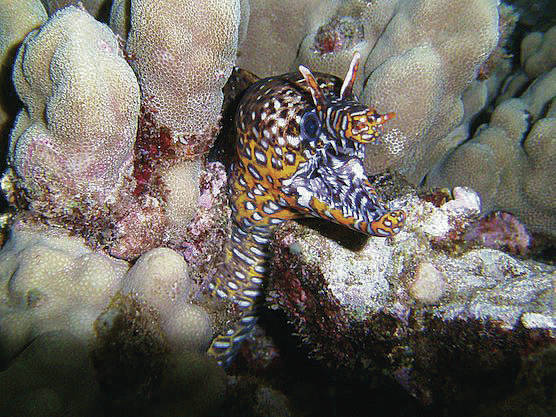Column: Ban commercial air transport of sea life for aquarium sales

COURTESY CHRISTOPHER HURST
“Check numerous studies online and you’ll see that only a very small percentage of the Hawaiian fish and creatures that are taken this way ever survive to get to their destination or stay alive for even a single month. The destruction and waste for a profit in this business is staggering, not to mention the incredible damage to the reefs,” writes Christopher Hurst.
It was over 25 years ago that I first came across aquarium hunters in Maui who had taken a number of species, including a harlequin shrimp. This creature usually has a mate close by and it looked very forlorn at the bottom of a 5-gallon bucket. I know these rare creatures to be very curious and friendly, oftentimes climbing your arm to visit with a diver. No one would ever see this creature again on the ocean floor.
On March 23, 2016, I was driving by Koloa Landing on Kauai after dinner and saw a light in the water. This is one of the only areas I know of where Hawaiian dragon moray eels commonly come out in the daytime. My wife and I have been studying these creatures for 12 years now and have documented a group of them on Maui at night. We have taken thousands of photos of this group and can identify individuals by their markings, tracking their location and habits over the years. The ones on Maui can be seen only at night, which is also when aquarium hunters usually try to harvest them.
Sure enough, a short time later, an infamous commercial aquarium hunter came out of the water with his catch. I looked in the back of his car and saw plastic tubs of many types of reef creatures. One tub had three adult dragon morays swimming in panic. Koloa Landing is where divers on Kauai routinely enjoy seeing these remarkable creatures. I had documented nine of them at Koloa Landing in recent days. Since the visit by that aquarium hunter, this group has never fully recovered.
I complained to the state Department of Land and Natural Resources the next morning, and two of the dragon morays that were still alive were returned back into the ocean. These creatures can sell for over $1,000 on the internet. That aquarium hunter had bragged that he gets as much as $7,000 for a single species of rare Hawaiian fish.
Check numerous studies online and you’ll see that only a very small percentage of the Hawaiian fish and creatures that are taken this way ever survive to get to their destination or stay alive for even a single month. The destruction and waste for a profit in this business is staggering, not to mention the incredible damage to the reefs.
The recent decision by Hawaii courts to finally end this business is a welcome development. The state Legislature can take one more step to stop the illegal actors who will continue this practice as long as there is a profit in it. Ban the commercial transport of all aquarium fishes or creatures from the state of Hawaii by any method.
Don't miss out on what's happening!
Stay in touch with breaking news, as it happens, conveniently in your email inbox. It's FREE!
Common carriers should have done this a very long time ago on their own. Hawaii residents and travelers should boycott the use of any air carrier that is still shipping these packages. They are extremely easy to identify. If the Legislature will impose a ban, the carriers would immediately stop these shipments. They would risk having their aircraft being impounded while a search warrant is being prepared and executed, delaying their other legal cargo and passengers. This simple common-sense legislative measure would end this practice and the destruction of Hawaiian reefs.
Christopher Hurst is a part-time Maui resident and retired member of the Washington State House of Representatives; a lifelong SCUBA diver, he and his wife have been divers in Hawaii since 1994.



